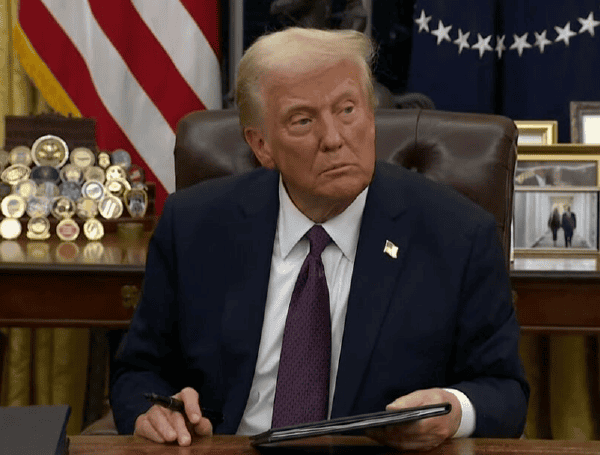President Donald Trump has officially imposed steep tariffs on imports from Mexico, Canada, and China, fulfilling a key campaign promise while raising concerns about higher prices for American consumers and potential global economic instability.
The tariffs, signed into effect via executive order Saturday, include:
- A 25% tariff on imports from Canada and Mexico (except for a 10% tariff on Canadian oil)
- A 10% tariff on all imports from China
- The possibility of further escalations if these countries retaliate
The White House stated that the tariffs are intended to pressure these nations to take stronger action against fentanyl smuggling, but they also align with Trump’s protectionist trade philosophy, aimed at boosting U.S. manufacturing and using tariffs as a source of federal revenue.
READ: U.S. Military Strikes ISIS In Somalia, Marking First Under Trump’s Second Term
Speaking from Palm Beach, Florida, Trump emphasized that the U.S. economy is strong enough to withstand any trade disruptions caused by the tariffs.
“You see the power of the tariff,” Trump told reporters on Friday. “Nobody can compete with us because we have by far the biggest piggy bank.”
The move represents one of Trump’s boldest economic actions in his second term, putting America on a collision course with its three largest trading partners.
The White House insists the tariffs are necessary to combat the flow of fentanyl and illegal immigration, particularly along the northern and southern borders.
“Immediate action is required to finally end this public health crisis and national emergency,” Trump stated in his executive order, citing the rising number of fentanyl-related deaths in the U.S.
READ: President Trump Signs Executive Order To ‘Unleash Prosperity’ Through Deregulation
Trump accused Canada of failing to crack down on drug cartels operating within its borders, pointing to fentanyl production in British Columbia and an increase in illicit drug smuggling across the northern border. His order also expands his previous national emergency declaration to officially include the northern border as a security risk.
However, economic experts warn that tariffs will increase costs for American consumers, potentially driving higher inflation at a time when the Federal Reserve is still working to stabilize the economy.
Trump’s executive order explicitly warns against retaliation from Canada, Mexico, and China, stating that if they impose counter-tariffs on American exports, the U.S. will escalate its trade penalties even further.
Canadian Prime Minister Justin Trudeau has already threatened retaliatory measures, and Mexico’s government has denounced the tariffs as unfair and economically harmful.
READ: Defense Secretary Pete Hegseth Issues Guidance: “Identity Months Dead At DoD”
China, meanwhile, has remained quiet, but analysts predict Beijing will hit back with its own tariffs on U.S. goods, particularly agricultural products and high-tech components.
The announcement sent shockwaves through financial markets, with the S&P 500 dropping sharply on Friday as investors braced for potential disruptions to supply chains and increased costs for manufacturers.
Trump, however, dismissed concerns, arguing that tariffs would help reduce U.S. dependence on foreign imports and generate additional revenue for the federal government.
“We were the richest country in the world,” Trump said, referencing the U.S. economy in the 1890s under President William McKinley, a staunch proponent of tariffs. “We were a tariff country.”
Please make a small donation to the Tampa Free Press to help sustain independent journalism. Your contribution enables us to continue delivering high-quality, local, and national news coverage.
Connect with us: Follow the Tampa Free Press on Facebook and Twitter for breaking news and updates.
Sign up: Subscribe to our free newsletter for a curated selection of top stories delivered straight to your inbox.

